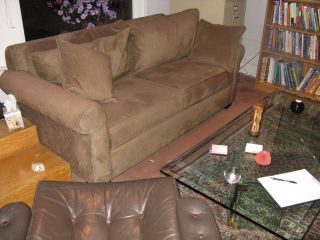
If you see clients, whether as a psychologist, lawyer, financial planner, whatever, you, of course, want your clients to feel comfortable and to trust you. Of course, nothing takes the place of kind competence but how you set up your office can get you off on the right or wrong foot.
Here, I describe how I set up my career counseling office. You might well not want to or be able to do all I’ve done but I hope that you’ll find at least something of value.
My waiting room is decorated without ostentation. I wouldn’t want my clients to think I was decorating poshly on their fees. On the sofa table is a copy of a photo-rich book, The Meaning of Life, a couple of the books I’ve authored, and a three-ring binder of my articles that my clients are likely to find particularly helpful. If I hadn’t written anything, I’d include thank-you letters from pleased clients. There’s also a little sign pointing to the bathroom.
My office, similarly, is decorated only in middle-middle-class style, in muted colors. The walls are a light blue-gray and the carpet is reddish brown, the wall trim is off-white. In addition to a comforting but thought-inducing painting and a print, the wall does bear my Ph.D. diploma—Although what I learned at school only minimally informs my work, I’m guessing that clients gain confidence from seeing it. There are three file cabinets and four bookcases filled with professional books. I allow my desk to be its natural moderately messy self. Perhaps I’m rationalizing, but I think it may help clients feel comfortable: that I have a busy practice and that I’m not unduly perfectionistic but not a pig.
The office is very quiet: carpets, double-glazed windows, and a quiet heating/air-conditioning system make the setting restful. Noise, over time, becomes straining. An unobtrusive clock lets me monitor the session's pace without the client worrying about it. Of course, if s/he wants to monitor the time, s/he can consult her watch, but she's not forced to do so.
People vary in temperature needs, so if I sense the client is warm or cold, I ask the client if s/he'd like me to adjust the temperature.
I sit in a comfortable chair opposite an equally comfortable sofa about 30” away and 45-degrees. I recall reading that that those are optimal for making people feel comfortable.
There’s a table that sits in front of the sofa. In addition to the legal pad on which I take notes, there’s a crystal apple that a client gave me, an 8-ball, a kaleidoscope, and a koosh ball. They all lend a relaxed touch. But clients’ fave is that, alongside my business card, my dog, Einstein has one, with his photo on it. His title: “Receptionist and Co-counselor.” When I reorder, I’ll add “Stress Reducer.”
I keep a box of tissues next to the sofa, which gives clients a little cue that it’s fine to show emotion in our sessions.
Carefully planning your office not only comforts the client but you. After all, you too are more likely to be at your best when your environment feels right for you.
So now, what if anything do you want to change about your office?
Marty Nemko's bio is in Wikipedia.


